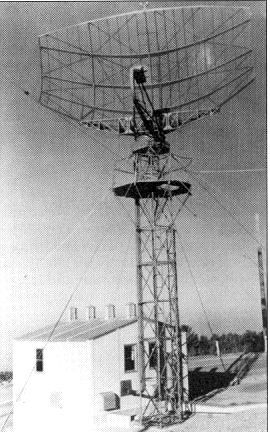The AN/FPS-8 Radar was a Medium-Range Search Radar used by the United States Air Force Air Defense Command.
 General Electric AN/FPS-8 Radar | |
| Country of origin | United States |
|---|---|
| Manufacturer | General Electric |
| Introduced | 1954-1958 |
| No. built | Over 200 produced |
| Type | Medium-Range Search Radar |
| Frequency | 1280 - 1380 megahertz |
| PRF | 360 hertz |
| Beamwidth | 2.5 degrees |
| Pulsewidth | 3 microseconds |
| RPM | 0 to 10 rpm |
| Power | 1 MW |
| Other Names | AN/GPS-3, AN/MPS-11, AN/FPS-88 |
The radar was a medium power D-Band search radar designed for aircraft control and early warning, and was installed at commercial airports and military bases both in the United States and overseas. In most installations the antenna was exposed, being mounted on a temporary tower.
For severe environmental conditions, the AN/FPS-8 was self-contained in an arctic tower with a protective radome. Over the years improvements were made to the basic AN/FPS-8, culminating in the final version whose nomenclature was AN/FPS-88 (V). The AN/FPS-8 also had two mobile versions: the AN/MPS-11 and the AN/MPS-11A.
Classification of radar systems
Under the Joint Electronics Type Designation System (JETDS), all U.S. military radar and tracking systems are assigned a unique identifying alphanumeric designation. The letters “AN” (for Army-Navy) are placed ahead of a three-letter code.[1]
- The first letter of the three-letter code denotes the type of platform hosting the electronic device, where A=Aircraft, F=Fixed (land-based), S=Ship-mounted, and T=Ground transportable.
- The second letter indicates the type of equipment, where P=Radar (pulsed), Q=Sonar, and R=Radio.
- The third letter indicates the function or purpose of the device, where G=Fire control, R=Receiving, S=Search, and T=Transmitting.
Thus, the AN/FPS-8 represents the 8th design of an Army-Navy “Fixed, Radar, Search” electronic device.[2][1]
References
See Also
External links
Wikiwand in your browser!
Seamless Wikipedia browsing. On steroids.
Every time you click a link to Wikipedia, Wiktionary or Wikiquote in your browser's search results, it will show the modern Wikiwand interface.
Wikiwand extension is a five stars, simple, with minimum permission required to keep your browsing private, safe and transparent.
